
Written by: Bettina Zammit
Although it may be more desirable to remain blissfully unaware, it is immensely important to address and to inform yourself about the diseases that are regarded as the top killers worldwide: Cardiovascular diseases. Below, you can read about the risk factors that may lead to heart disease, symptoms of a heart attack, and a step-by-step guide on how you may save a life using an AED.
Risk factors for heart disease
Pertinent risk factors for cardiovascular disease include the use of tobacco, high amounts of alcohol intake, air pollution, a high BMI index, and low levels of exercise. Studies have shown that an unhealthy diet, which is one that consists of a high intake of processed foods, trans and saturated fats, food items with high amounts of salt and sugar, and drinks with high sugar levels, is a primary cause for the development of heart disease. High serum cholesterol and high blood pressure levels are regarded as two of the leading causes of the development of ischaemic heart disease.

A large number of the risk factors that lead to heart disease are modifiable. Nowadays, easily accessible tools, such as exercise and nutrition apps, are ideal to keep you motivated to maintain healthy habits that reduce the risk of heart disease development.
Although the risk may be decreased through lifestyle changes, there are a few risk factors that must be continually monitored for, despite having a healthy lifestyle. Hypertension and atherosclerosis are two of these types of risk factors that are commonly encountered.
Hypertension
Also known as high blood pressure, may not result in symptoms despite it being present. Hypertension which goes unnoticed and untreated has the potential to be seriously damaging to the heart, and thus, may result in heart attacks, heart failure, and even sudden death. Hypertension can be monitored by measuring blood pressure regularly.

Atherosclerosis
Atherosclerosis is a condition in which arteries become clogged due to a buildup of plaques, which are fatty substances. Consequently, arteries become hardened and narrowed, resulting in a decrease in the amount of blood flow to vital organs, and an increase in the risk of blood clot formation. Blood clots may result in heart attacks or strokes.
This condition typically does not present with any symptoms, and therefore, oftentimes goes unnoticed. However, if atherosclerosis remains untreated, cardiovascular diseases, such as coronary heart disease, heart attacks, and strokes may develop.
Myocardial infarction
A myocardial infarction, more commonly known as a heart attack, occurs when there is a sudden blockage of blood flow to the heart, which typically arises due to the presence of a blood clot.
The symptoms of myocardial infarction include chest pain which may radiate to the jaw, neck, arms and back, shortness of breath, experiencing lightheadedness and/or weakness, and experiencing feelings of extreme anxiety.
Heart attacks pose life-threatening danger, and cause extreme damage to the heart muscle; it is of utmost importance that if you feel any of the symptoms mentioned, you seek medical treatment immediately.
The importance of AEDs and how to use them
Sudden cardiac arrest is treated using an AED (Automated External Defibrillator). This is a device that is used to determine heart rhythm and will provide an electrical shock. The electrical shock will aid in reobtaining a regular heart rhythm.
AEDs in Malta may also be found in public spaces and buildings. For instance, in Valletta, AEDs may be found at:
- Chemimart in Republic Street
- Chemimart at the City Gate
- Empire Pharmacy in Old Theatre Street
- Castille Hotel in Castille Square
- Marsamxetto Harbour
- Bus Terminus – Near Tal-Linja Kiosk
Every minute is crucial in the case of sudden cardiac arrest; each minute that defibrillation is not provided reduces the chance of survival by 10%. Therefore, since there is a certain amount of time that it takes for medical assistance to arrive at the scene, it is vital that everybody is aware of how to use AEDs. Hence, people have the power to potentially save a life.

Steps to take when using an AED
- Retrieve the AED and switch it on.
- Expose the person’s chest and ensure that it is dry.
- Open and apply the AED pads.
- One pad must be applied on the upper right chest above the breast.
- The other must be applied on the lower left chest below the armpit.
- If the individual has a device such as a pacemaker, position the pads in such a way that they do not make contact with the device.
- Ensure that the wires are attached to the AED box as necessary.
- Stop CPR and stand clear of the person. Ensure that neither you, nor any other bystanders, are touching the individual.
- Let the AED analyse the rhythm.
- Read the AED message provided. This message may read:
- “Check electrodes”: in this case, ensure that the electrodes are attached to the skin properly.
- “Shock”: in this case, ensure that the individual is clear, and press and hold the “shock” button until the AED delivers the shock
- Resume giving CPR.
- Repeat these steps.
More articles by MHSA here.

